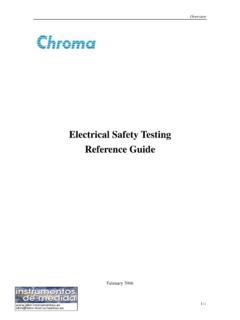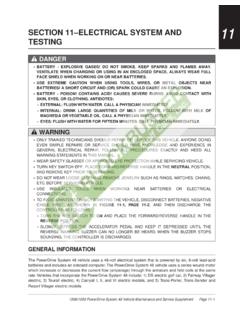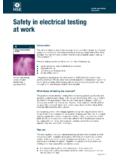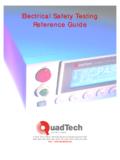Transcription of Electrical safety and you - Health and Safety Executive
1 Page 1 of 6 Health and Safety ExecutiveElectrical Safety and you A brief guideThis is a web-friendly version of leaflet INDG231(rev1), published 04/12 Introduction Electricity can kill or severely injure people and cause damage to property. Every year many accidents at work involving electric shock or burns are reported to the Health and Safety Executive (HSE). Most of the fatal incidents are caused by contact with overhead power lines. Even non-fatal shocks can cause severe and permanent injury. For example, shocks from faulty equipment may lead to falls from ladders, scaffolds or other work platforms. Those using or working with electricity may not be the only ones at risk poor Electrical installations and faulty Electrical appliances can lead to fire, which may also cause death or injury to others.
2 Most of these accidents can be avoided by careful planning and straightforward precautions. This leaflet provides some basic measures to help you control the risks from your use of electricity at work. Further guidance for particular industries or subjects can be found on HSE s website ( ). What are the hazards? The main hazards are: n contact with live parts causing shock and burns normal mains voltage, 230 volts AC, can kill; n faults which could cause fire; and n fire or explosion where electricity could be the source of ignition in a potentially flammable or explosive atmosphere. Assessing the risk Your Health and Safety risk assessment should take into account the risks associated with electricity.
3 It will help you decide what action you need to take to use and maintain your Electrical installations and equipment and also how often maintenance is needed. See HSE s website for further guidance ( ). The risk of injury from electricity is strongly linked to where and how it is used. The risks are greatest in harsh conditions, for example: n in wet surroundings unsuitable equipment can easily become live and can make its surroundings live; n outdoors equipment may not only become wet but may be at greater risk of damage; and n in cramped spaces with a lot of earthed metalwork such as inside a tank if an Electrical fault developed it could be very difficult to avoid a shock. Health and Safety ExecutiveElectrical Safety and you: A brief guide Page 2 of 6 Some items of equipment can also involve greater risk than others.
4 Extension leads are particularly liable to damage to their plugs, sockets, connections and the cable itself. Other flexible leads, particularly those connected to equipment which is often moved, can suffer from similar problems. Reducing the risk Once you have completed the risk assessment, you can use your findings to reduce unacceptable risks from the Electrical equipment in your workplace. There are many things you can do to achieve this, and some of them are listed people working on or with your Electrical equipment or systems are competent for the taskCompetent means having suitable training, skill, and knowledge for the task to prevent injury to themselves and others. Ensure the Electrical installation is safe Make sure that: n new Electrical systems are installed to a suitable standard, eg BS 7671 Requirements for Electrical installations,1 and then maintain them in a safe condition; n existing installations are maintained in a safe condition; and n you provide enough socket outlets because overloading socket outlets by using adaptors can cause safe and suitable equipment n Choose equipment that is suitable for its working environment.
5 N Electrical risks can sometimes be eliminated by using air, hydraulic or hand- powered tools which are especially useful in harsh conditions. n Make sure that equipment is safe when supplied and that it is then maintained in a safe Provide an accessible and clearly identified switch near each fixed machine to cut off power in an emergency. n For portable equipment, use socket outlets which are close by so that equipment can be easily disconnected in an emergency. n The ends of flexible cables should always have the outer sheath of the cable firmly clamped to stop the wires (particularly the earth) pulling out of the terminals. n Replace damaged sections of cable completely. n Use proper connectors or cable couplers to join lengths of cable.
6 Do not use strip connector blocks covered in insulating tape. n Some types of equipment are double insulated. These are often marked with a double-square symbol .The supply leads have only two wires live (brown) and neutral (blue). Make sure they are properly connected if the plug is not moulded. n Protect light bulbs and other equipment which could easily be damaged in use. n In potentially flammable or explosive atmospheres, only special Electrical equipment designed for these areas should be used. You may need specialist the voltageOne of the best ways of reducing the risk of injury when using Electrical equipment is to limit the supply voltage to the lowest needed to get the job done, such as: n temporary lighting can be run at lower voltages, eg 12, 25, 50 or 110 volts; Health and Safety ExecutiveElectrical Safety and you: A brief guide Page 3 of 6n where electrically powered tools are used, battery-operated ones are safest; or n portable tools designed to be run from a 110 volt centre-tapped-to-earth supply are readily a Safety deviceIf equipment operating at 230 volts or higher is used, an RCD (residual current device) can provide additional Safety .
7 An RCD is a device which detects some, but not all, faults in the Electrical system and rapidly switches off the supply. The best place for an RCD is built into the main switchboard or the socket outlet, as this means that the supply cables are permanently protected. If this is not possible, a plug incorporating an RCD or a plug-in RCD adaptor can also provide additional Safety . RCDs for protecting people have a rated tripping current (sensitivity) of not more than 30 milliamps (mA). Remember: n an RCD is a valuable Safety device, never bypass it; n if it trips, it is a sign there is a fault check the system before using it again; n if it trips frequently and no fault can be found in the system, consult the manufacturer of the RCD; and n the RCD has a test button to check that its mechanism is free and functioning you should use this out preventative maintenance All Electrical equipment, including portable equipment and installations, should be maintained (so far as reasonably practicable) to prevent danger; this is a requirement of the Electricity at Work Regulations 1989.
8 These Regulations state principles of Electrical Safety and apply to all Electrical systems and equipment. However, they do not specify what needs to be done, by whom or how frequently. Decisions on maintenance levels and the frequency of checks should be made in consultation with equipment users, based on the risk of Electrical items becoming faulty. There is an increased risk of this happening if the equipment isn t used correctly, isn t suitable for the job, or is used in a harsh environment. An appropriate system of maintenance is strongly recommended. This can include: n user checks by employees, eg a pre-use check for loose cables or signs of fire damage; n a visual inspection by someone with more knowledge, eg checking inside the plug for internal damage, bare wires and the correct fuse; and n where necessary, a portable appliance test (PAT) by someone with the necessary knowledge and experience to carry out a test and interpret the or defective equipment should be removed from use and either repaired by someone competent or disposed of to prevent its further use.
9 What does so far as reasonably practicable mean?You do not have to remove all the risks but the law requires you to do everything reasonably practicable to protect people from harm. An explanation of what is reasonably practicable means is provided at and Safety ExecutiveElectrical Safety and you: A brief guide Page 4 of 6 Not every Electrical item needs a PAT and those that do may not need to be tested every year By concentrating on a simple, inexpensive system of looking for visible signs of damage or faults, most of the Electrical risks can be is no legal requirement to label equipment that has been inspected or tested, nor is there a requirement to keep records of these activities. Although it is not a legal requirement, maintaining a record and labelling system can be a useful way to monitor and review the effectiveness of the maintenance scheme.
10 Guidance on portable appliance testing, including the frequency of checks, is available in the booklets mentioned later and in the frequently asked questions at is recommended that fixed installations (the wiring and equipment between the supply meter and the point of use, eg socket outlets) are inspected and tested periodically by a competent person. Work safelyMake sure that people who are working with electricity are competent to do the job. Even simple tasks such as wiring a plug can lead to danger ensure that people know what they are doing before they that: n suspect or faulty equipment is taken out of use, labelled DO NOT USE and kept secure until examined by a competent person; n where possible, tools and power socket outlets are switched off before plugging in or unplugging.

















